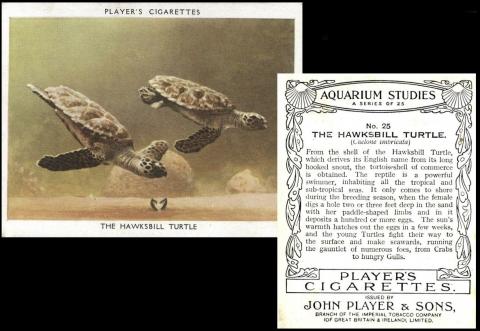
Hawksbill turtles live in both tropical and subtropical waters of the Atlantic, Pacific, and Indian Oceans. They roam far from home and commute between feeding sites and nesting grounds, because the female turtles nest on the beach where they were born, mostly this seems to be in Nicaragua and El Salvador. They are named after their pointed, bird-like beak, and they are one of the few animals to eat marine sponges
Human beings get in the way of this idyllic life; they steal their eggs, hunt them for meat, and are most enamoured with their shells, which are brightly coloured and which we call tortoiseshell.And we also kill them when they get trapped in fishing nets.
This is a really unusual set and the pictures are wonderful, though the large size always makes for better pictures, don't you think? And that's not a mistake, by the way, for the date of issue, right down to the very day was actually recorded in the London Cigarette Card Company's "Cigarette Card News Magazine" in 1933.
The first mention of this new set in our literature is in our original Players Reference Book RB.17, where it is described as
10. 25 AQUARIUM STUDIES. Large cards. Fronts in colour. Backs in grey with descriptive texts. Home Issue. September 1932."
As usual by the time of our original World Tobacco Issues Index in 1956 this had been reduced to "Lg. Nd. (25)" - which tells you why our original checklist style books are so sought after. And our most recent World Tobacco Issues Index repeats this basic information only, but gives us a new code.
The hawksbill turtle also appears in a trade set, "Wonders of the Deep" which was issued by several tea companies, namely Wilcocks and Wilcocks of Exeter (WIA-8 : WIL-090) & Browne Bros Ltd of Southend (BRO-930 .: BRT-9) both in 1965, Northern Co-operative Society of Aberdeen (NOI-7 : NOR-310) in 1966, H.E. Empson & Son of Birmingham (EMP-210 : EMP-8) in 1967 and even Polar Products of Barbados in about 1970, which has no code as our Trade Indexes are U.K. only.
